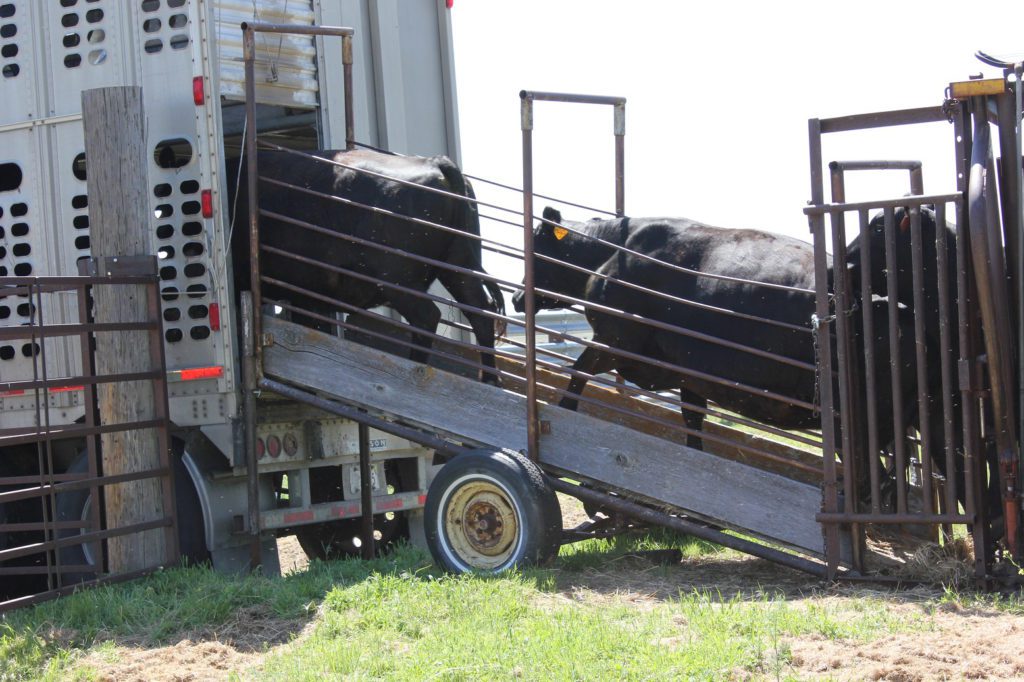Transportation plays an important role in cattle production. The majority of cattle in the United States have been transported with a stock trailer or semi cattle truck at least once in their life time.
Data on transportation was collected in the 2016 National Beef Quality Audits for both fed cattle and market cows/bulls being moved to harvest facilities.
Travel time can effect cattle shrink and stress. It was found that fed cattle are on the truck an average of 2.5 hours or transported an average of 135 miles en route to packing plants. Market cows and bulls were hauled an average of 9.3 hours and approximately 400 miles which is due to the location of cow and bull harvest facilities in relation to where many cow/calf operations are located. The maximum transportation times collected were 12 hours for fed cattle and 39 hours for cows/bulls. The longer and farther animals are transported can impact carcass traits due to stress. In extreme conditions like heat and cold, time on the trailer without proper airflow or protection from the elements adds to the effects on carcass traits.
Mobility scoring data was also collected during unloading at the harvest facilities. Fed cattle scores set the benchmark high as nearly 97% showed no signs of lameness and 3% had minor stiffness. The industry can improve fitness to travel with additional training of producers and transporters. Cattle with major stiffness or injury need to be further evaluated to determine proper steps to follow: delay to allow time to improve, transport to a local emergency processor, or euthanasia of downer or extremely high risk animals. Some might be assessed safe to ship but should be last to load and then unload first off the truck. These determinations should be discussed between key feedyard and transport personnel to ensure cattle safely arrive at their destination.
One area of focus that could be linked to transportation relates to bruising on carcasses. The audit observed 39% of fed cattle carcasses had bruises which was a 16% increase from the 2011 audit. The majority of these bruises (77%) were minimal requiring less than one pound of trim and 20% major with 1-10 pounds of trim. Using 2016 loin values, a minimal bruise costs $2.85 and a major bruise $28.82. Bruises were located in the loin (29.7%), round (27.8%), chuck (16.4%), rib (14.4%) and brisket/plate (11.6%). Bruising can occur from a number of situations, such as, improper use of a sort tools, overcrowded handling facilities, and loads shifting during transit with cattle bumping each other. There has also been research conducted on large cattle trailers. Cattle have increased in frame and weight in recent years while transportation trailers have not changed to fit these animals. There needs to be continued work in this area to make improvements and decrease losses to the industry. Incorporating good stockmanship during sorting, loading and unloading can assist in reducing bruising.
National Beef Quality Assurance has developed a new BQA Transportation program to train transportation handlers/drivers in proper Best Management Practices (BMP). These practices include handling, trip planning, load densities, biosecurity, managing weather extremes, and general driver safety. BQA Transportation is offered in two tracts, one design for on-farm and ranch personnel and the other for professional drivers. Both tracts can be completed free online at bqa.org or face-to-face trainings can be planned through local state BQA with a minimal certification fee. Professional BQA Transportation Certification is a requirement for truck hauling animals into major beef packers in 2020.
For more information visit BQA.org
Source: Rob Eirich, Nebraska Director of BQA and Extension Beef Educator








